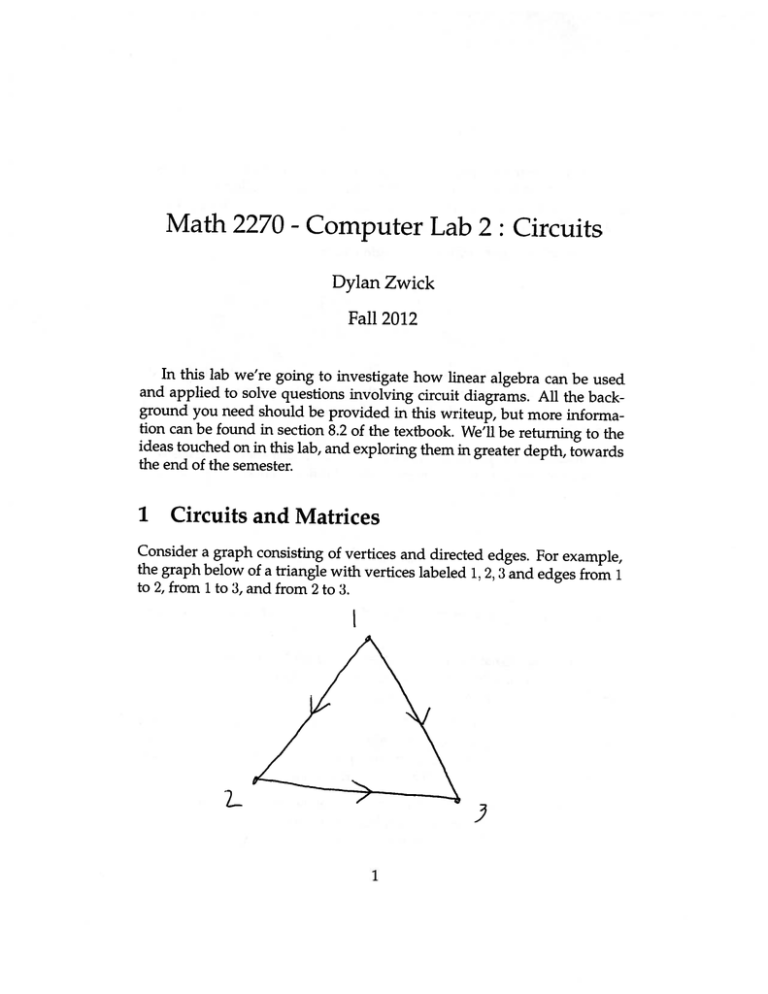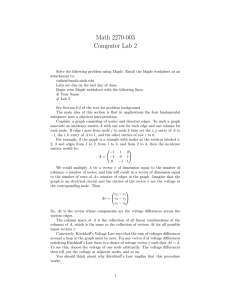Math 2270 Computer Lab 2: Circuits Dylan Zwick Fall 201.2
advertisement

Math 2270 Computer Lab 2: Circuits - Dylan Zwick Fall 201.2 In this lab we’re going to investigate how linear algebra can be used and applied to solve questions involving circuit diagrams. All the back ground you need should be provided in this writeup, but more informa tion can be found in section 8.2 of the textbook. We’ll be returning to the ideas touched on in this lab, and exploring them in greater depth, towards the end of the semester. 1 Circuits and Matrices Consider a graph consisting of vertices and directed edges. For example, the graph below of a triangle with vertices labeled 1. 2. 3 and edges from 1 to 2, from 1 to 3, and from 2 to 3. L 3 1 To any directed graph we associated an incidence matrix A with one row for each edge, and one column for each vertex. If edge i goes from node jto node k then set the i, i-entry of A to —1, the i, k-entry of A to 1, and the other entries of row ito 0. The incidence matrix for our triangle will be: 1 0 01 —1 1 (—1 A=(-l 0 If we multiply A by a vector v of dimension equal to (the number of columns of A = number of vertices of the graph), we get an output vector b of dimension equal to (the number of rows of A = number of edges of the graph). Imagine that the graph is an electrical circuit and the entries of the vec tor v are the voltages at the corresponding vertices. Then in the example of our triangle we’d have: Av = / ( —1 i 1 0 0 —1 — / “\ ) f v ) ‘ J 0 \ 1 1 Vj 3 C = / f k\ V2 v — — — 1 V 1 V 2 C ) ) b. This vector b gives us the voltage drop across each of our respective edges. The column space of A is the collection of all linear combinations of the columns of A, which is the same as the collection of vectors Av of all possible voltage drops across our edges. The nullspace of A will be the collection of all vertex voltages such that the voltage drop across every edge is 0. This will only happen if all the voltages are the same. So, the nulispace is a one dimensional space consisting of all vectors v with all entries the same. Now, Ohm’s law says that the voltage drop across an edge is equal to the current through the edge multiplied by the resistance of the edge, or Ill. If we assume that each edge has resistance put more succinctly, V 2 ic (1 Ohm) then the current through the edge in Amps is equal to the voltage difference across the edge in Volts. Kirchoff’s Current Law says that the current flowing into a vertex equals the current flowing out, unless the vertex is a source of a sink. If the vector c represents the current through each edge then the current flowing out of each vertex is ATc. For our triangle this is: ATc= / f —1 .1 0 —1 0 1 0 —[ 1 \ Ici ) ( ) \c 2 c —c — Cl (2 — — + 2 C 3 C 3 C ) Now, suppose that we introduce an external current s flowing into node 1 and a ground at node 3. 3 The grounded note has voltage zero, and has net current flowing out. For the other vertices (only vertex 2 in the case of our triangle), the current flowing in matches the current flowing out, so our circuit satisfies: ( ) 3 The current vector c, assuming the resistance across all edges if ic, is Av, so our equation above becomes: ATAv= () We can find the voltage at each node, given by the vector v, by solving this equation. Now, we recall the nulispace of A is one dimensional, so there is exactly one free column in A, and one free variable in v. Vertex 3 is 3 0, and we solve for a particular grounded, so we set that free variable v solution. Finally, we could have different resistances across the edges. We can ac count for this by introducing a square, diagonal “resistance matrix” whose where 2, is the resistance of edge i. For example, diagonal i, i entry is suppose in our triangle edges 1 and 2 have resistance ic, while edge 3 has resistance 2c2. Then our resistance matrix is -, C / I 1 0 () () 1 0 0 0 To find the voltages we solve the equation: Once the voltages are known we find the currents through each edge by computing CAy. For our particular problem if we set s 4 = -t the solution is: 2 in Maple is pretty easy, but we must use Maple’s Solving for u, and t’ “solve” command. We cannot solve the equation by taking the inverse of the matrix on the left, because the matrix on the left will always be singular.’ , with v 2 3 = U, is available on the Maple code for solving for vt and v class website. Please look through this code and read it for understanding, as it utilizes the same approach you’ll apply for the more difficult problem below. W know this because is has a non-trivial nulispace. 5 2 Maple Problem For the following network diagram, find the voltage at each numbered node and the current flow across each numbered edge, given the following assumptions: The resistance across each edge is 112 except for c2 and U, which have resistance 5. There is a current of 12A that enters node 1 from the top, and a current of 12A that exits node 7 from the bottom. The voltage at node 7, v , is set of U. 7 1z4 elO e9 For your writeup, you should hand in a printout with your name on it of the Maple code you use to answer the above question, along with, of course, the answer. The Maple code should look similar to the example code used to solve the triangle problem. 6





